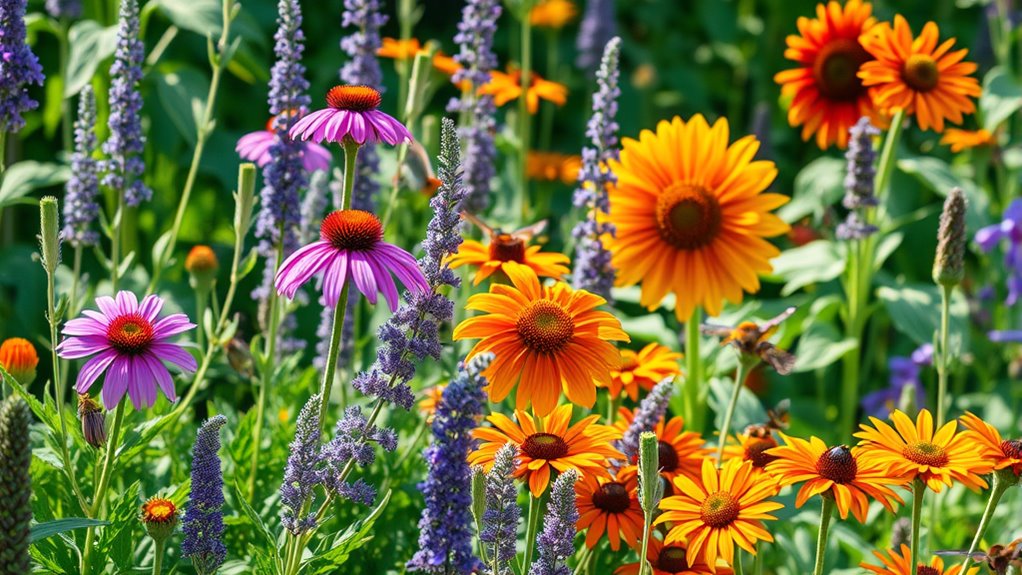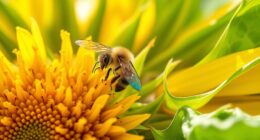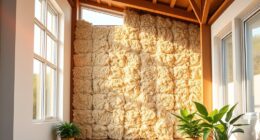If you want to attract bees and butterflies, I recommend planting native wildflowers like milkweed, yarrow, blue flax, and California poppy, along with garden favorites like sunflowers, zinnias, and cosmos. These plants provide nectar and habitat for pollinators throughout the season. Using a mix of annuals and perennials helps guarantee ongoing blooms. Keep watching to discover more about the best pollinator-friendly plants to help your garden thrive and support local ecosystems.
Key Takeaways
- Native wildflowers like California poppy, yarrow, and blue flax effectively attract bees and butterflies to gardens.
- Incorporating nectar-rich plants such as sunflowers, cosmos, and bachelor buttons supports pollinator health.
- Combining perennials and annuals ensures continuous bloom and a steady food source for pollinators.
- Using pollinator-friendly seed mixes boosts biodiversity and provides habitat for beneficial insects.
- Proper planting in full sun with suitable soil conditions enhances pollinator attraction and garden success.
Seed Needs Pollinator Seed Mix Honey Bee Blend Wildflowers
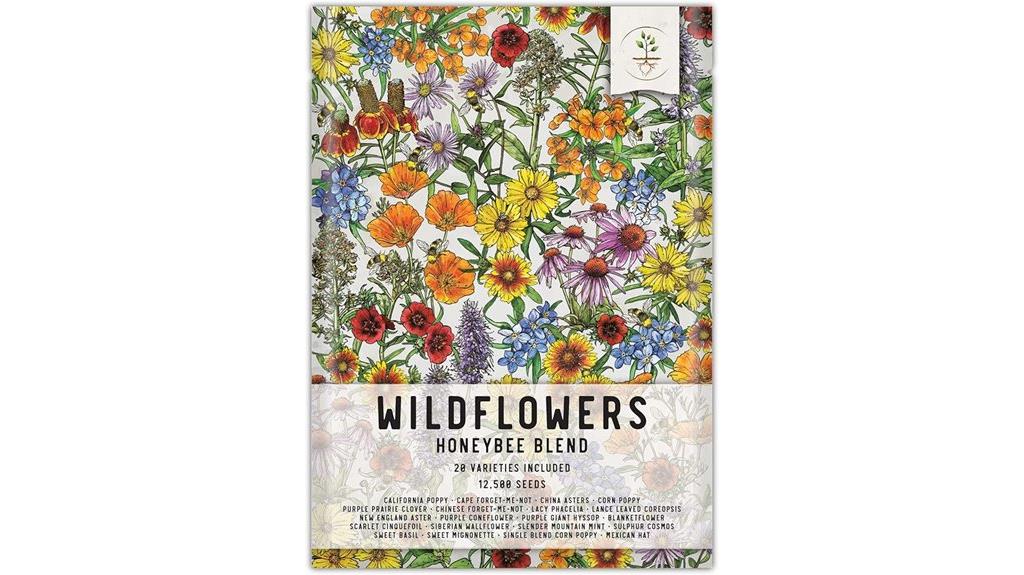
If you’re looking to support pollinators like honeybees, the Seed Needs Pollinator Seed Mix Honey Bee Blend Wildflowers is an excellent choice. This 1-ounce packet contains 16 native wildflower species, including Black-Eyed Susan, Purple Coneflower, Columbine, and White Yarrow. It’s packed with 100% pure live seed, with no fillers, ensuring healthy growth. Designed to attract bees and butterflies, these perennials grow from 12 to 48 inches tall and produce vibrant, colorful blooms. Perfect for wildflower gardens or ecological restoration, this mix helps sustain pollinator populations while creating a beautiful, bee-friendly landscape.
Best For: gardeners, conservationists, and homeowners seeking to support pollinator populations and create vibrant, bee-friendly landscapes.
Pros:
- Contains 16 native wildflower species that attract pollinators like bees and butterflies
- 100% pure live seed with no fillers, ensuring healthy and vigorous growth
- Supports ecological restoration and promotes biodiversity in gardens and landscapes
Cons:
- May require specific soil and sunlight conditions for optimal growth
- Wildflower germination can take time, requiring patience for blooms to appear
- Perennials may need maintenance or dividing over multiple seasons to sustain vibrant displays
BUZZY Wildflower Pollinator Seed Mix (1lb)
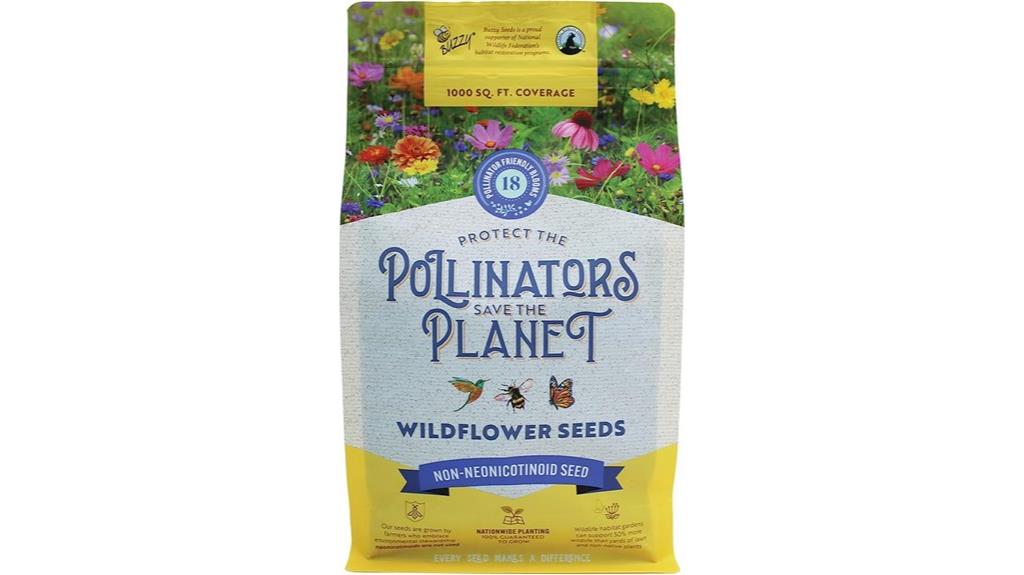
The Buzzy Wildflower Pollinator Seed Mix (1lb) is perfect for gardeners who want to support pollinator health while adding vibrant blooms to their landscape. This mix includes 18 varieties like Coreopsis, Zinnia, Black-Eyed Susan, and Lavender, providing continuous nectar throughout the season. It’s easy to grow and promotes ecological health by creating essential habitats for bees, butterflies, and other pollinators. Whether you’re planting for conservation or beauty, this seed mix offers a rewarding gardening experience. Plus, it’s a thoughtful gift or event favor, encouraging awareness and action for pollinator protection. Guaranteed to sprout with simple planting instructions.
Best For: Gardeners and conservation enthusiasts seeking to support pollinator health, enhance landscape beauty, and promote ecological sustainability with easy-to-grow wildflower mixes.
Pros:
- Contains 18 diverse, pollinator-friendly wildflower varieties for continuous nectar and bloom throughout the season
- Easy to plant with simple instructions and a growth guarantee, suitable for gardeners of all experience levels
- Promotes environmental conservation by creating vital habitats for bees, butterflies, and other pollinators
Cons:
- May require specific planting conditions for optimal growth, which could be challenging in certain climates
- The 1lb seed mix may be insufficient for large-scale planting projects without additional purchase
- Some varieties might not thrive in heavily shaded or poorly drained soils
Set of 8 Wildflower Seed Mix for Pollinators
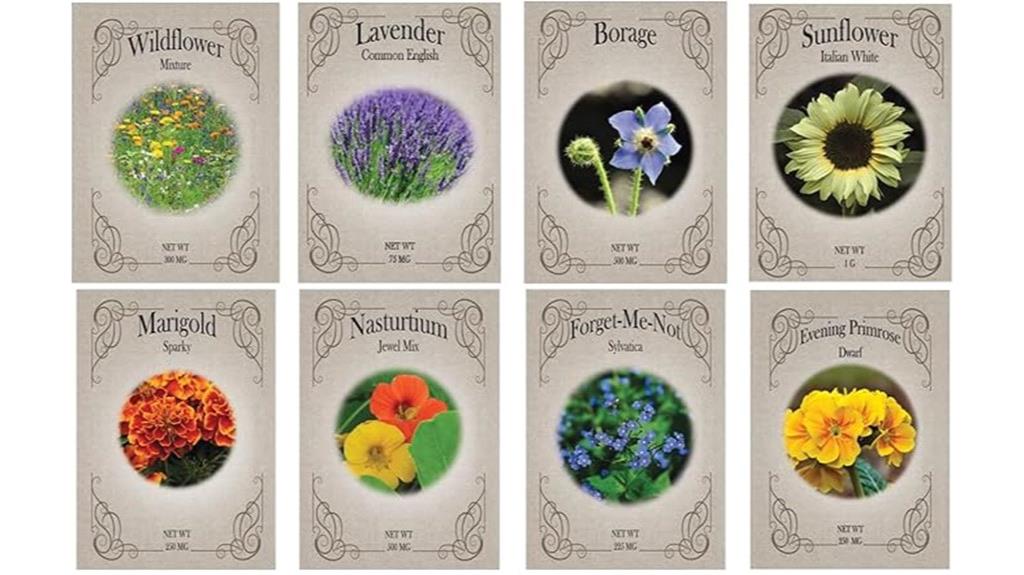
Gardeners and nature enthusiasts who want to support pollinator populations will find the Set of 8 Wildflower Seed Mix especially valuable. This diverse mix includes heirloom, non-GMO varieties like lavender, borage, sunflowers, marigolds, nasturtiums, evening primrose, and forget-me-nots, all designed to attract bees, butterflies, and hummingbirds. It provides nectar-rich blooms from spring through fall, thriving in full sun or partial shade. Easy to grow and drought-tolerant, it’s suitable for gardens, containers, or meadows. With a high germination rate, it quickly establishes a vibrant, pollinator-friendly landscape that promotes biodiversity and supports ecosystem health.
Best For: gardeners, flower lovers, beekeepers, and nature enthusiasts seeking to support pollinator populations and enhance their outdoor spaces with easy-to-grow, biodiverse wildflowers.
Pros:
- Attracts and nourishes bees, butterflies, hummingbirds, and other pollinators.
- Includes heirloom, non-GMO seeds with high germination rates for reliable growth.
- Suitable for various settings, including gardens, containers, meadows, and raised beds.
Cons:
- May require regular watering during establishment, especially in drought-prone areas.
- Slight variability in blooming times depending on local climate and conditions.
- Price and availability could vary based on retailer or season.
20 Mimosa Flower Seeds from USA, Pollinator Friendly
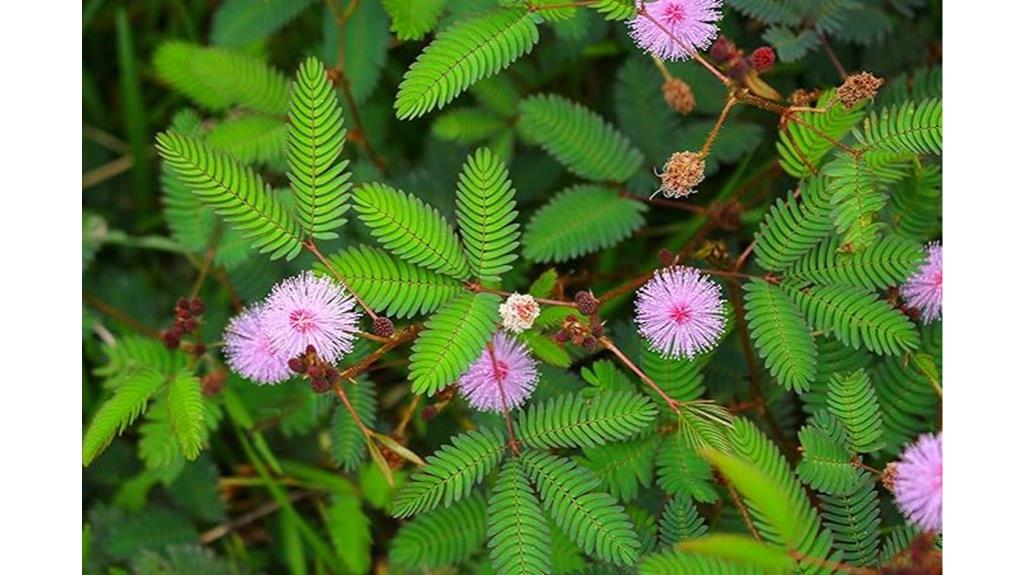
For those looking to attract pollinators to their outdoor space, the Mimosa Flower Seeds from the USA offer an excellent choice. Made in Iowa, these 20 seeds are pollinator-friendly and appeal to kids, making them perfect for patios, lawns, or gardens. I appreciate that they’re from CZ Grain, a trusted brand, and that they’re available at a competitive price. While the package doesn’t include planting instructions, I find that mimosa plants are easy to grow and attract bees and butterflies naturally. Shipping is straightforward, and I like that customer feedback is encouraged, helping me make informed purchasing decisions.
Best For: gardeners and outdoor enthusiasts seeking a pollinator-friendly plant to attract bees, butterflies, and kids to their patios, lawns, or gardens.
Pros:
- Made in the USA, ensuring quality and supporting local manufacturing
- Pollinator-friendly, promoting healthy ecosystems and natural pollination
- Appealing to children, making gardening an educational and fun activity
Cons:
- No specific planting instructions included, which may require additional research
- Limited information on germination time or growth requirements
- Shipping and price details vary, potentially affecting overall cost and availability
Plant Pollination Tool, USB Rechargeable Vibrating Pollinator for Greenhouse Crops

If you’re growing crops indoors or in greenhouses with limited natural pollinators, the USB rechargeable vibrating pollinator is an excellent choice. Its bee-shaped design mimics real pollinators, making it both functional and charming. Compact and lightweight, it’s easy to handle with one hand, reaching multiple flowers comfortably. The gentle vibrations support pollen transfer, boosting fruit production for crops like tomatoes, strawberries, and peppers. It’s rechargeable via USB, with a full charge taking about 6-7 hours. Many users report increased yields and better flowering, especially in environments where natural pollinators are scarce. It’s a practical tool for enhancing indoor crop success.
Best For: indoor gardeners, greenhouse growers, and hobbyists seeking to enhance pollination and fruit yield in environments with limited natural pollinators.
Pros:
- Mimics natural bee vibrations, improving pollen transfer and plant productivity.
- Compact, lightweight, and easy to handle with one hand for efficient use across multiple flowers.
- Rechargeable via USB, offering convenience and eco-friendly operation.
Cons:
- May have reduced effectiveness on very small flowers due to larger bee head design.
- Some users experience vibration loss or device malfunction after weeks of use.
- Noise level can be loud enough to disturb the garden environment or deter pests but may also bother users.
Survival Garden Seeds Pollinator Flower Collection
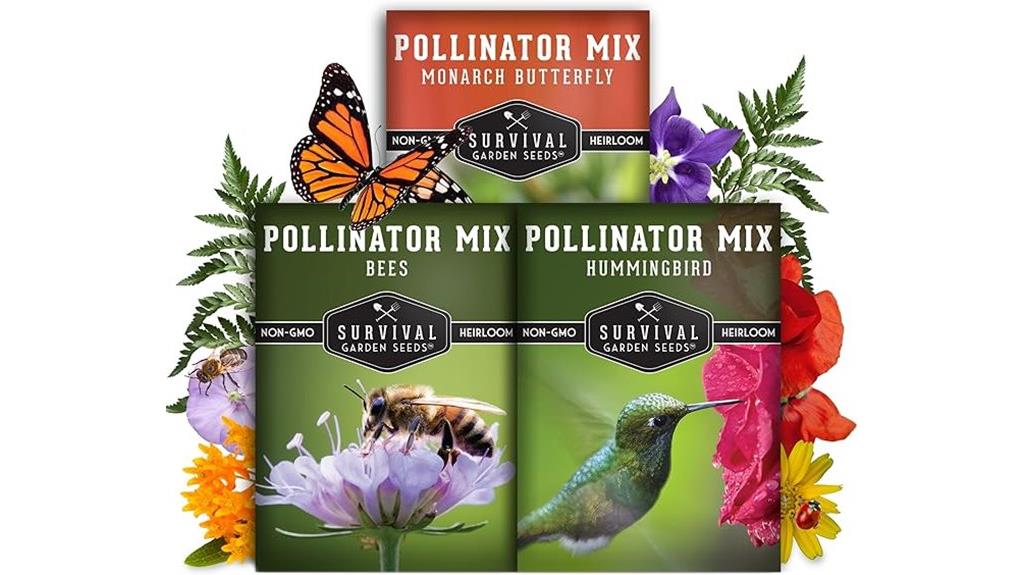
Are you looking to boost pollinator populations and create a vibrant, wildlife-friendly garden? The Survival Garden Seeds Pollinator Flower Collection makes that easy. It includes three seed packs designed to attract butterflies, bees, hummingbirds, and other beneficial insects with nectar- and pollen-rich wildflowers and garden favorites. The collection features a variety of perennial and annual mixes like Butterfly Milkweed, Purple Coneflower, and Scarlet Sage, suitable for outdoor planting across USDA Zones 4-11. These non-GMO, untreated seeds are easy to grow in full sun and moderate water conditions, providing colorful blooms from spring to fall and supporting local pollinator health.
Best For: gardeners and outdoor enthusiasts looking to attract pollinators, enhance biodiversity, and create colorful, wildlife-friendly gardens across USDA Zones 4-11.
Pros:
- Includes a diverse variety of nectar- and pollen-rich wildflowers and garden favorites perfect for attracting butterflies, bees, hummingbirds, and beneficial insects.
- Non-GMO, untreated, heirloom seeds with high germination rates, ensuring healthy plant growth and vibrant blooms from spring to fall.
- Suitable for multiple garden settings, including flower beds, containers, and wildflower patches, with easy outdoor planting in full sun and moderate watering.
Cons:
- Some users have experienced delays in blooming or lower germination rates, which may be related to seed age or planting conditions.
- Occasional reports of missing seed packets or packaging issues, potentially impacting the planting experience.
- Requires proper storage and care to maintain seed viability over time, as seeds are best kept in a cool, dry place.
Hale Habitat & Seed Bee Lawn Mix, Pollinator Friendly & Low Maintenance
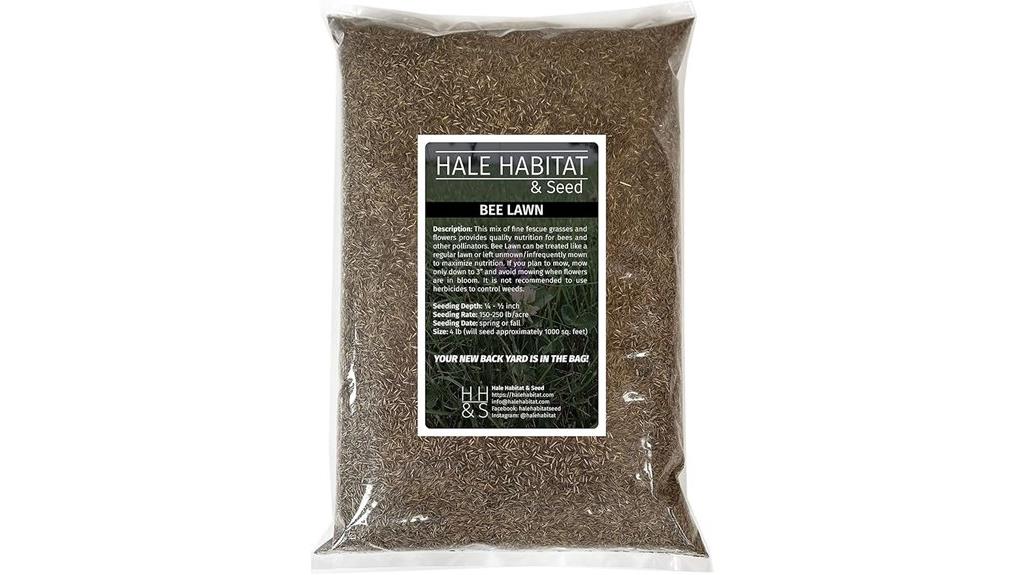
Hale Habitat & Seed Bee Lawn Mix stands out as an ideal choice for gardeners seeking a low-maintenance, pollinator-friendly lawn solution. This blend covers about 1,000 square feet with just 4 pounds of seed, featuring fine fescue grasses and flowering plants that attract bees and butterflies. It’s suitable for full sun or partial shade, thrives with moderate watering, and grows to around 3 inches tall. Mowing at 3 inches and avoiding cutting during bloom supports pollinator health. Certified for high germination and eco-friendly, it offers an easy, sustainable way to create habitat and support biodiversity in your yard.
Best For: gardeners seeking an easy-to-maintain, environmentally friendly lawn that supports pollinators and enhances biodiversity.
Pros:
- Supports bee populations and pollinator health with flowering plants and grasses.
- Low-maintenance, similar to regular lawn care with recommended mowing height of at least 3 inches.
- Certified for high germination rate, eco-friendly, and suitable for various sunlight conditions.
Cons:
- Customer reviews indicate inconsistent germination; some users report poor sprouting or no growth.
- Price may be higher compared to other seed blends, and availability varies by retailer.
- Requires moderate watering and proper planting conditions; failure to follow instructions can affect results.
Pollinator Seed Mix for Monarch Butterflies and Bees

Looking to support pollinators like monarch butterflies and bees in your garden? A pollinator seed mix is a perfect way to do that. It includes milkweed, native wildflowers, and garden flowers that bloom from spring to fall, providing continuous nectar. The mix contains high-quality, untreated, heirloom seeds, including milkweed, which is essential for monarch caterpillars. It attracts a variety of pollinators, boosting local biodiversity. Easy to grow, the seeds can be started indoors or directly sown outside, with instructions included. This mix is ideal for meadows, wildflower gardens, or pollinator habitats, helping conservation efforts while beautifying your space.
Best For: Gardeners, conservationists, and outdoor enthusiasts looking to support pollinator populations and enhance biodiversity through easy-to-grow native wildflower and milkweed mixes.
Pros:
- Contains high-quality, untreated, heirloom, non-GMO seeds that are tested for germination success.
- Supports multiple pollinators including monarch butterflies, bees, and hummingbirds with continuous bloom times from spring to fall.
- Suitable for both beginners and experienced gardeners, with detailed planting instructions included.
Cons:
- Germination may be delayed in some cases, depending on local conditions and seed quality.
- Results can vary based on planting location, soil, and climate, which may affect bloom success.
- Some users have reported variability in seed quality or slower growth, requiring patience and proper planting techniques.
Pollinators Delight | Flower Seed Grow Kit | The Jonsteen Company

If you’re passionate about supporting local pollinators and creating vibrant, eco-friendly landscapes, the Pollinators Delightfrom The Jonsteen Company is an excellent choice. It includes 25 carefully selected wildflower species that attract bees, butterflies, and beneficial insects. With enough seed to cover around 150 square feet, you can easily establish a colorful, thriving wildflower field. This kit is perfect for all ages and skill levels, making it ideal for educational projects, community gardens, or personal landscapes. Plus, it comes with a 100% germination guarantee, ensuring your efforts grow into a beautiful, pollinator-friendly environment.
Best For: eco-conscious gardeners, educators, and community organizers seeking an easy, effective way to support pollinator populations and create vibrant wildflower landscapes.
Pros:
- Includes 25 diverse wildflower species that attract pollinators like bees and butterflies
- Covers approximately 150 square feet, ideal for large planting areas or multiple projects
- 100% germination guarantee with free replacements if seeds do not sprout
Cons:
- May require additional soil preparation for optimal growth in certain areas
- Not suitable for regions with very short growing seasons or extreme weather conditions
- The kit does not include planting tools or detailed planting instructions
Electric Flower Pollinator Mini Handheld Pollination Tool with Soft Silicone Brush for Indoor and Outdoor Use
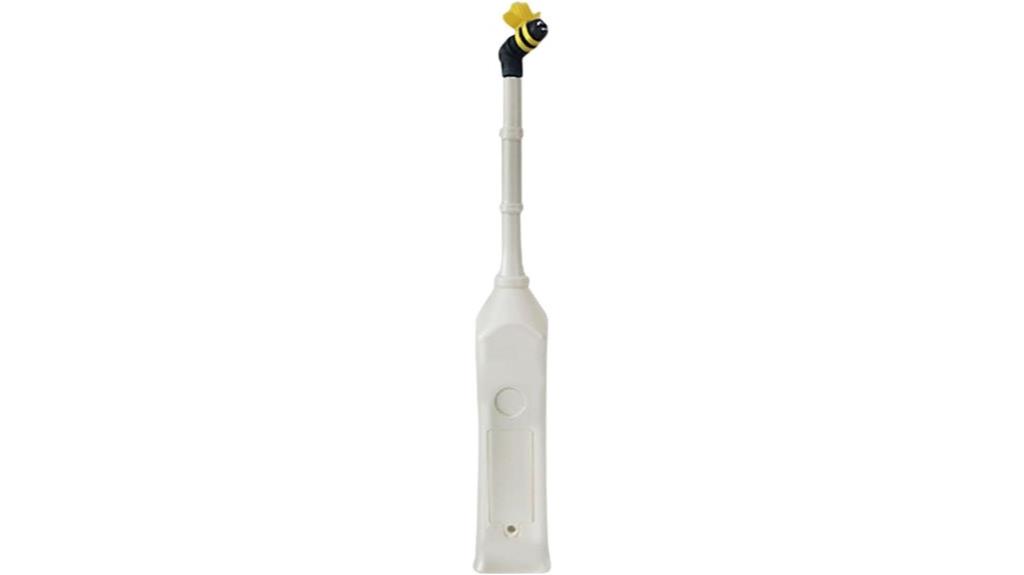
The Electric Flower Pollinator Mini Handheld Pollination Tool is an ideal choice for gardeners who want a convenient, lightweight device to enhance pollination both indoors and outdoors. Its compact size and soft silicone brush make it easy to use without damaging delicate flowers. Made from durable plastic, it’s safe for various plants like cherry trees, fruit, and vegetables. Powered by hand, no batteries are needed, and its cordless design allows for quick, on-the-go pollination. Whether you’re working in a greenhouse or your backyard, this tool simplifies the process and helps boost flowering and fruiting, making pollination more efficient and accessible.
Best For: indoor and outdoor gardeners seeking an easy, portable tool to improve pollination for flowers, fruits, and vegetables without the need for batteries or wires.
Pros:
- Compact, lightweight, and portable for convenient use anytime and anywhere.
- Soft silicone brush ensures gentle contact, protecting delicate flowers.
- Cordless and manual operation eliminate the need for batteries or power sources.
Cons:
- Mixed user reviews suggest it may not be equally effective for all plant types, such as tomatoes.
- Limited size may require multiple uses for larger pollination tasks.
- The manual operation might require more effort compared to automated pollinators.
3 Pack Bee Pollinator Mix Seeds for Attracting Bees in Gardens

Gardeners aiming to support pollinators will find this bee pollinator mix seed pack an excellent choice, especially since it’s designed to attract a variety of bees, butterflies, and hummingbirds. The three-pack contains heirloom, non-GMO, untreated seeds featuring wildflower and garden species like California Poppy, Purple Coneflower, and Baby Blue Eyes. These nectar- and pollen-rich plants support honey bees, native bees, and bumblebees, boosting garden biodiversity. You can plant now or store the seeds for future seasons, as they remain viable when kept in a cool, dry place. Easy to follow instructions assure successful growth, making this mix perfect for both beginner and experienced gardeners.
Best For: gardeners and conservationists seeking to support pollinator populations and promote biodiversity in their gardens.
Pros:
- Contains heirloom, non-GMO, untreated, open-pollinated seeds for healthy plant growth.
- Attracts a wide variety of pollinators including bees, butterflies, hummingbirds, and birds.
- Seeds are viable for years when stored properly and come with detailed planting instructions suitable for all experience levels.
Cons:
- Requires proper storage conditions to maintain seed viability over time.
- Planting success may vary depending on climate and soil conditions.
- May take several weeks to months for plants to produce flowers and attract pollinators.
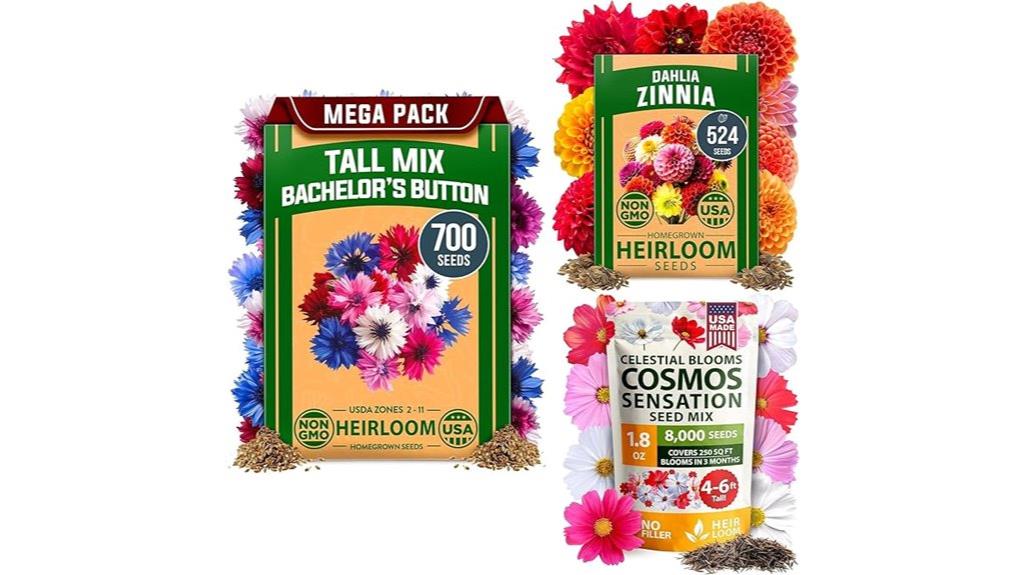
Looking to attract bees and butterflies to your outdoor space? I recommend the Pollinator-Friendly Wildflower Seed Mix, which includes Bachelor Button, Zinnia, and Cosmos. These easy-to-grow, quick-blooming flowers are non-GMO and grown in the USA, making them perfect for supporting local pollinator populations. The mix is low-maintenance and germinates rapidly, adding vibrant color while boosting biodiversity. Whether you have a small garden or larger space, this seed blend attracts beneficial insects and enhances ecological health. It’s a simple, effective way to create a beautiful, pollinator-friendly environment that benefits both your garden and the pollinators.
Best For: Gardeners and environmental enthusiasts seeking an easy, effective way to support pollinators and enhance garden biodiversity with attractive, quick-blooming wildflowers.
Pros:
- Attracts bees, butterflies, and other beneficial pollinators, supporting local ecosystems
- Non-GMO, USA-grown seeds ensure quality and safety for pollinators and gardeners
- Easy-to-grow with rapid germination, making it suitable for gardeners of all experience levels
Cons:
- Blooming may vary depending on local climate and growing conditions
- Limited to the specific flower types included, which may not cover all pollinator preferences
- Price may fluctuate based on retailer and location, requiring price tracking for best deals
Pollinator Mix of California Wildflowers (2g)

If you’re passionate about supporting local pollinators and creating a vibrant California garden, the Pollinator Mix of California Wildflowers (2g) is an excellent choice. This diverse blend includes annuals and perennials like California poppy, blue flax, yarrow, and baby blue eyes, all designed to attract bees and butterflies. Produced by a family-owned, eco-friendly seed company, it guarantees high germination rates and sustainable practices. Perfect for California gardens, it offers colorful, long-lasting blooms that boost ecological health and biodiversity. Whether you’re planting a small patch or a large landscape, this seed mix provides a beautiful, pollinator-friendly display that supports local ecosystems.
Best For: garden enthusiasts and conservationists seeking a sustainable, pollinator-friendly wildflower mix tailored for California environments.
Pros:
- Supports local pollinators like bees and butterflies, enhancing ecological health.
- Includes a diverse blend of annuals and perennials for long-lasting garden beauty.
- Produced by a family-owned, eco-friendly seed company committed to sustainability and high germination rates.
Cons:
- May require specific California climate conditions for optimal growth.
- Limited to a 2-gram seed packet, suitable for small planting areas but not large-scale landscapes.
- Availability may vary depending on online or offline retail options.
100pcs Hand Pollination Tool for Garden and Indoor Plants
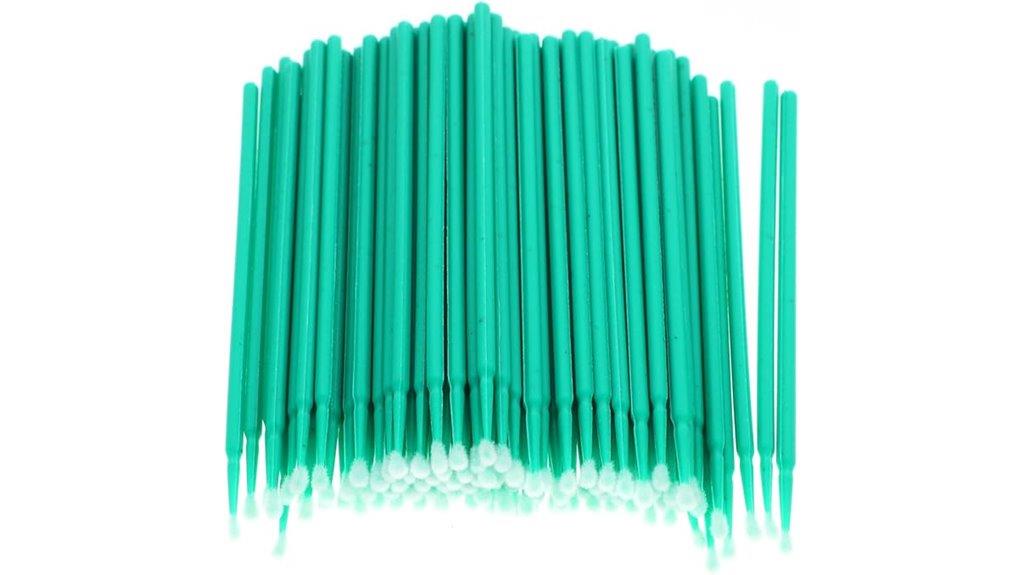
The 100pcs Hand Pollination Tool is an ideal choice for anyone aiming to boost crop yields with minimal effort. It’s perfect for vegetables and fruits, whether you’re gardening indoors or outdoors. The lightweight, durable design makes it easy to handle and clean, while its simple structure suits all skill levels. This tool guarantees precise, repeatable pollination, helping you increase fruit and vegetable production. It’s especially useful for crops like pears, tomatoes, eggplants, and peppers. Reusable and long-lasting, it reduces dependence on natural pollinators and bees, making manual pollination more efficient and reliable for gardeners and farmers alike.
Best For: Gardeners, farmers, and indoor plant enthusiasts seeking an efficient, reusable tool to manually pollinate vegetables and fruits with precision and ease.
Pros:
- Lightweight and durable, easy to handle and clean
- Suitable for all skill levels, ensuring consistent pollination
- Reusable for many years, offering long-term value
Cons:
- May require some practice to achieve optimal pollination results
- Limited to manual use, which can be time-consuming for large-scale operations
- Not a replacement for natural pollinators in outdoor environments
Deluxe Pollinators Garden Starter Kit

Gardeners enthusiastic to support pollinator populations and create a vibrant, native flower habitat will find the Deluxe Pollinators Garden Starter Kit an excellent choice. This kit includes nine seed packets of heirloom, non-GMO flowers like borage, nasturtium, marigold Sparky, and cosmos, along with 18 peat pots, 10 netted coir pellets, and a beginner’s guide. It’s designed for both indoor and outdoor use, making it versatile for new gardeners. The kit simplifies starting your pollinator garden by providing all essentials, though some may find the pots flimsy or the seed quantities limited. Overall, it’s a solid option for those eager to attract bees and butterflies.
Best For: beginners and garden enthusiasts who want to support pollinator populations and create a native flower habitat both indoors and outdoors.
Pros:
- Includes a variety of heirloom, non-GMO flower seeds suitable for attracting bees and butterflies.
- Comes with all necessary starter materials such as peat pots and coir pellets, simplifying the gardening process.
- Designed for versatility, allowing use in indoor and outdoor settings to jumpstart a pollinator-friendly garden.
Cons:
- Some users find the seed quantities limited and the small, flimsy pots prone to breaking.
- The included pamphlet focuses more on vegetables than flowers, which may be less helpful for flower-focused gardening.
- The overall cost may be higher than purchasing seeds and supplies separately, considering the modest contents of the kit.
Factors to Consider When Choosing Pollinator‑Friendly Plants
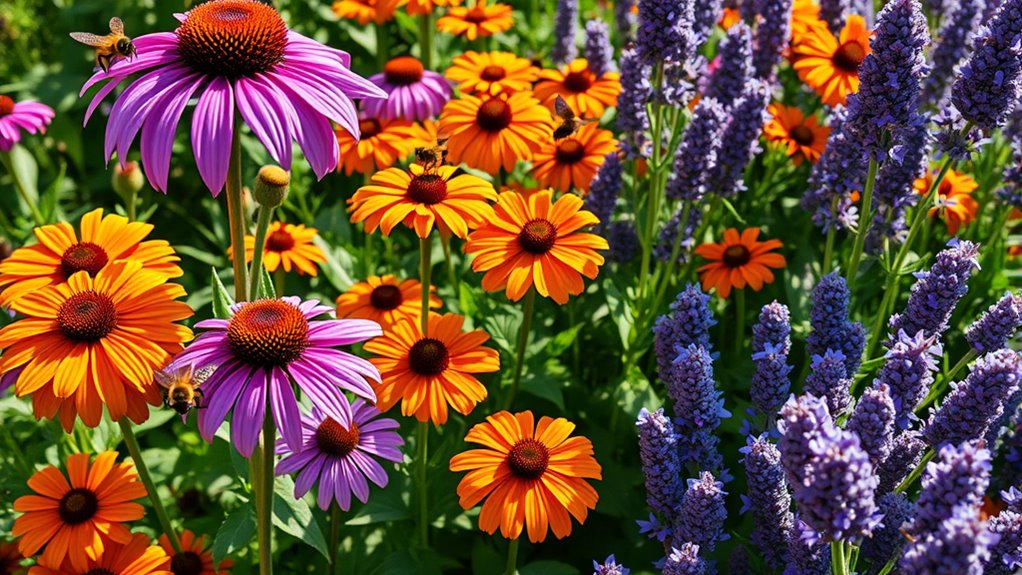
When choosing pollinator-friendly plants, I consider a variety of factors to guarantee a healthy and vibrant garden. I look at flower types and bloom times to provide continuous food, and I prefer native or well-adapted species for better success. Additionally, I pay attention to sunlight, soil needs, and the nectar and pollen content to support a diverse pollinator population.
Flower Diversity and Types
Choosing a variety of flower types and shapes is essential for attracting a wide range of pollinators. I recommend including annuals, perennials, and biennials to guarantee continuous nectar supplies throughout the growing season. Incorporate different flower shapes like tubular, open, and clustered blooms to appeal to various pollinator species with diverse feeding preferences. Selecting flowers with staggered bloom times creates a succession of flowering periods, supporting pollinators from early spring to late fall. Native wildflowers are particularly valuable because they enhance local biodiversity and attract native pollinators that prefer familiar nectar sources. Finally, a mix of bright colors such as yellow, purple, and red can boost pollinator visits and improve pollination efficiency, making your garden a thriving habitat for bees and butterflies.
Blooming Periods and Seasons
Ever wondered how to keep pollinators visiting your garden all year round? The key is selecting plants with staggered blooming periods, ensuring there’s always a nectar source from early spring to late fall. I recommend incorporating both early and late-blooming species, which support pollinators during different seasons. Native wildflowers are especially effective since they naturally bloom during peak pollinator activity in your area. Keep in mind that some plants only bloom once a year, so mixing multiple species can extend the flowering season. To maximize benefits, check the specific bloom times of different plant varieties. By thoughtfully choosing plants with varied blooming periods, you create a continuous, lively habitat that sustains bees and butterflies throughout the year.
Native and Adapted Species
Selecting pollinator-friendly plants that are native or well-adapted to your area is essential for a thriving garden. Native plants are better suited to your local climate, soil, and seasonal conditions, which means they’re more likely to survive and bloom successfully. They also provide familiar nectar and pollen sources that support native pollinators, helping maintain ecological balance. Using these plants reduces the need for extra watering, fertilizers, and pesticides, making your garden more sustainable. Additionally, native species have often co-evolved with local pollinators, leading to more effective pollination and increased visitation rates. Incorporating native and adapted plants not only benefits your garden’s health but also helps preserve regional biodiversity and strengthens the resilience of local ecosystems.
Nectar and Pollen Content
When selecting pollinator-friendly plants, it’s crucial to take into account their nectar and pollen content, as these resources directly impact pollinator health and activity. Plants that produce abundant nectar and high-quality pollen are essential for attracting bees, butterflies, and other pollinators, providing the energy and nutrients they need. The amount and accessibility of nectar vary among species, with some offering more readily available sources that support a diverse range of pollinators. Pollen richness and nutritional content are equally important, as they supply essential proteins for pollinator development. Native plants often provide better nectar and pollen resources tailored to local pollinators’ needs. Additionally, choosing plants with staggered bloom times and continuous flowering ensures a steady food supply throughout the pollination season.
Sunlight and Soil Needs
Choosing the right pollinator-friendly plants depends heavily on understanding their sunlight and soil requirements. Most thrive in full sun, meaning at least six hours of direct sunlight daily, which encourages abundant nectar and pollen production. Soil needs vary; many native wildflowers prefer well-draining, loamy soil that isn’t too acidic or alkaline. Some plants do better in slightly acidic to neutral pH levels, around 6.0 to 7.0, to ensure healthy growth and flowering. Drought-tolerant varieties often thrive in poorer soils with low fertility, reducing watering needs. By evaluating your garden’s sunlight exposure and soil composition, you can select plants that will flourish and attract pollinators effectively, creating a vibrant, sustainable habitat.
Plant Height and Spacing
Considering plant height and spacing is essential for creating a healthy, pollinator-friendly garden. I recommend selecting plants with mature heights that suit your space, ensuring smaller plants aren’t overshadowed or crowded. Proper spacing, usually 12 to 24 inches apart, promotes good air circulation and makes it easier for pollinators to access flowers. Think about each plant’s growth habit—whether it’s low ground cover, bushy, or tall—and match that to your garden layout. Including a mix of heights—tall, medium, and low—adds layered habitat diversity. Adequate spacing also supports healthy root development and prevents competition for nutrients, water, and sunlight. This thoughtful arrangement helps your garden thrive and attracts a variety of pollinators throughout the season.
Maintenance and Growth Rate
Selecting pollinator-friendly plants involves more than just their appearance and size; understanding their growth rates and maintenance needs helps make certain a thriving garden. Fast-growing plants can quickly establish vibrant habitats and offer immediate nectar for pollinators, which is especially helpful early in the season. Perennials typically require less maintenance over time compared to annuals, which need replanting each year, making them an easier choice for ongoing care. Plants with low water and nutrient needs are generally simpler to maintain and can thrive with minimal intervention. Choosing native species often results in healthier, more resilient plants that grow reliably with standard gardening practices. Additionally, understanding each plant’s growth cycle and flowering period ensures continuous support for pollinators throughout the season.
Frequently Asked Questions
How Do I Select Plants Suitable for My Specific Climate Zone?
To choose plants suited for my climate zone, I check my USDA Hardiness Zone, which tells me which plants thrive locally. I visit local nurseries or extension offices to get zone-specific recommendations. I also consider my soil type, sun exposure, and moisture levels. By selecting plants adapted to my environment, I guarantee they’ll flourish, attracting bees and butterflies while thriving with less maintenance.
What Are the Best Planting Times to Attract Pollinators?
I find that planting early in spring and again in late summer or early fall works best to attract pollinators. I aim to have blooms during peak bee and butterfly activity, usually from April to October, depending on my climate. I also stagger planting times and choose plants that bloom at different times, ensuring there’s always something to attract pollinators throughout the season.
How Can I Prevent Invasive Species From Spreading in My Pollinator Garden?
Think of invasive species as unwelcome guests crashing your garden party. To keep them at bay, I recommend planting native, pollinator-friendly plants—they’re like a welcoming handshake that keeps invasives out. Regularly monitor your garden, remove unwanted plants early, and avoid spreading seeds from invasive species. By tending with care, you’re creating a safe haven where bees and butterflies can thrive without competition from invasive guests.
What Additional Habitat Features Support Local Pollinator Populations?
Adding features like bare soil patches, dead wood, and native plant clusters creates essential habitats for pollinators. I also include water sources like shallow dishes or small ponds to support their hydration needs. Providing nesting sites, such as bee hotels or brush piles, encourages local bees and butterflies to settle and thrive. These habitat features help sustain healthy pollinator populations, ensuring a vibrant, productive garden year-round.
How Do I Maintain Year-Round Bloom for Continuous Pollinator Attraction?
To maintain year-round bloom and keep pollinators coming, I plan my garden with a mix of plants that bloom at different times. I choose early spring bulbs, summer flowers, and late-season favorites, ensuring continuous nectar sources. I also deadhead spent blooms to encourage more flowering and avoid over-fertilizing, which can hinder blooms. Regular watering and mulching help plants stay healthy and bloom longer throughout the year.
Conclusion
Imagine your garden as a bustling hive, alive with the vibrant dance of bees and butterflies. By choosing these pollinator-friendly plants, you’re inviting nature’s tiny workers to thrive and pollinate all around you. It’s a small act with a big impact — transforming your space into a colorful, buzzing sanctuary. So, let’s plant the seeds today and watch your garden bloom into a lively, joyful haven that celebrates life’s sweetest symphony.
